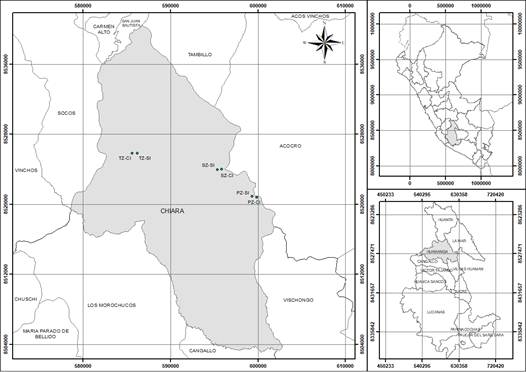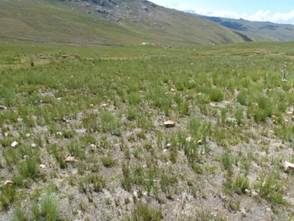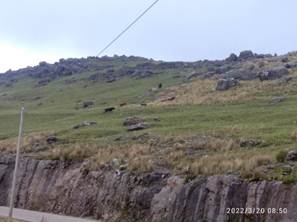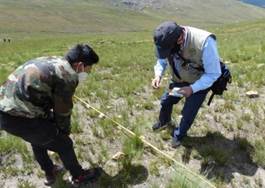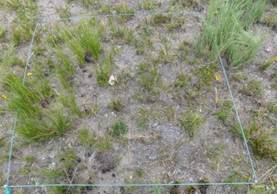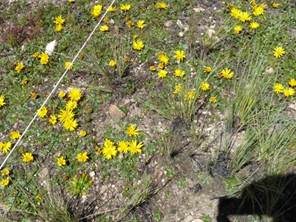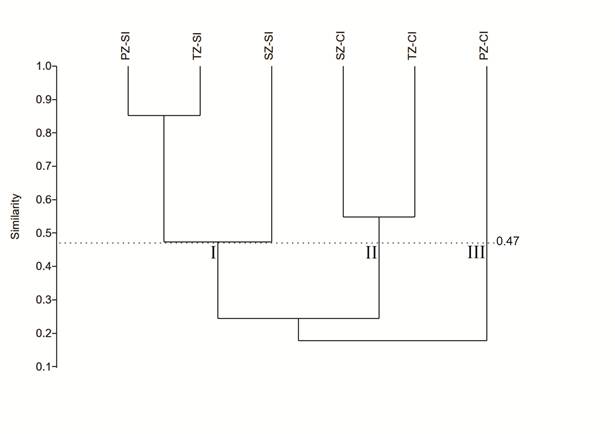Journal of the Selva Andina Biosphere
versión impresa ISSN 2308-3867versión On-line ISSN 2308-3859
J. Selva Andina Biosph. vol.11 no.1 La Paz 2023 Epub 01-Mayo-2023
https://doi.org/10.36610/j.jsab.2023.110100006
ARTÍCULOS DE INVESTIGACIÓN
Dynamics of post-fire natural regeneration of high Andean ecosystems in the district of Chiara. Ayacucho-Peru
1National University of San Cristobal de Huamanga. Academic Department of Biological Sciences. Faculty of Biological Sciences. Botany Laboratory. Independencia Av. s/n Ciudad Universitaria "Los Módulos". Ayacucho-Peru.
2 National University of San Cristobal de Huamanga. Academic Department of Biological Sciences. Faculty of Biological Sciences. Biotechnology Laboratory. Av. Independencia s/n Ciudad Universitaria "Los Módulos". Ayacucho, Peru.
Se estudió la dinámica de regeneración natural de ecosistemas altoandinos perturbados por incendios en el distrito de Chiara, Ayacucho - Perú. Se establecieron 3 zonas de estudio a lo largo de la carretera Ayacucho - Cusco, distrito de Chiara: Toccto, Incapaperqan y Qewillaqocha, caracterizadas por áreas con y sin impacto por incendios, aplicando el método de muestreo en transecto de banda. Se registró la flora dicotiledónea con 116 especies y monocotiledónea 40, en Qewillaqocha las especies más frecuentes fueron Festuca dolichophylla, Plantago australis, Luzula racemosa, Calamagrostis vicunarum, F. dolichophyla tuvo mayor cobertura, seguido de C. vicunarum. En densidad resaltaron especies rastreras y cespitosas como Lachemilla pinnata, L. racemosa; en vegetación sin impacto, F. dolichophylla es la más representativa seguido de C. vicunarum. En Incapaperqan, las especies vegetales están en rebrote, resaltando Bromus catharticus, F. dolichophylla, Poa sp., y Muhlenbergia peruviana, en la zona sin impacto predomina F. dolichophylla, seguido de L. pinnata y C. vicunarum. En Toccto, hay rebrotes de F. dolichophylla. En zona sin incendio, F. dolichophylla es la más frecuente, seguido de C. vicunarum. Las zonas incendiadas presentaron mayor riqueza de especies en relación a áreas sin impacto, los índices de diversidad son muy bajas en ambos casos. Las áreas afectadas se recuperarán con las primeras lluvias y estarán en pleno esplendor entre 4-5 años. F. dolichophylla no muere completamente en el incendio. En tanto la regeneración por semillas es muy lenta.
Palabras clave: Incendios; regeneración natural; ecosistemas altoandinos; pajonal
The dynamics of natural regeneration of high Andean ecosystems disturbed by fires in the district of Chiara, Ayacucho - Peru was studied. Three study zones were established along the Ayacucho - Cusco road, district of Chiara: Toccto, Incapaperqan and Qewillaqocha, characterized by areas with and without fire impact, applying the band transect sampling method. In Qewillaqocha the most frequent species were Festuca dolichophylla, Plantago australis, Luzula racemosa, Calamagrostis vicunarum, F. dolichophyla had the greatest coverage, followed by C. vicunarum. In density, creeping and cespitose species such as Lachemilla pinnata, L. racemosa stood out; in non-impact vegetation, F. dolichophylla was the most representative, followed by C. vicunarum. In Incapaperqan, plant species are in regrowth, highlighting Bromus catharticus, F. dolichophylla, Poa sp., and Muhlenbergia peruviana; in the non-impacted zone, F. dolichophylla predominates, followed by L. pinnata and C. vicunarum. In Toccto, there are resprouts of F. dolichophylla. In the non-fire zone, F. dolichophylla is the most frequent, followed by C. vicunarum. The burned areas presented higher species richness in relation to areas without impact, the diversity indices are very low in both cases. The affected areas will recover with the first rains and will be in full splendor within 4-5 years. F. dolichophylla does not die completely in the fire. Regeneration by seeds is very slow.
Keywords: Fire; natural regeneration; high Andean ecosystems; pajonal
Introduction
Throughout history, fire has played an important role in the evolution of ecosystems and human life. It is a natural regulator of ecological processes that helps maintain stability and promote ecological succession. However, human intervention has altered this stability, even in areas where fire was a natural process. This is reflected in important changes in the structure and composition of species1.
Nevertheless, the effects of fire on natural ecosystems are diverse and vary in extent2. Nevertheless, they play an important role in the dynamics and functioning of ecosystems worldwide. Fire is recognized as a natural disturbance in many ecosystems3, but it is also used as a tool in land management in many countries, especially to clear and prepare land for agricultural purposes4.
In the high part of the Chiara district, there are fragile ecosystems made up of grassy pastures and puna grasslands, with a particular biodiversity, which are at risk due to various factors such as human activities. In these areas, there have been more than 21 cases of forest fires (FI) in various ecosystems and ecological levels during the year 2020, affecting flora and wildlife.
Events caused by the inhabitants of nearby communities, most of them intentionally burned for economic and cultural purposes. Activities such as stubble burning, pasture improvement, intensive agriculture, among others. For the inhabitants, this activity is a necessity, except in cases where they cannot control the intensity of the fire, which becomes a problem. It is important to note that in these community’s fire was used as a management tool, unlike the perception of other people and public institutions2. In this regard, the human factor has a high incidence in its origin, about 96 % are due to negligent or intentional actions5.
However, from the scientific-environmental point of view, they are events that cause negative impacts on high Andean ecosystems. They have repercussions on biodiversity and the landscape, causing migration, death of wildlife, generating soil degradation, modifying its physical and chemical properties, and producing erosion due to the loss of vegetation cover. They also contribute to global warming by emitting carbon dioxide and altering the hydrological cycle6.
The Andean regions of Peru represent current climatic models, both for their climatic and geographic characteristics. Their climate is affected by human action or activities in other remote places that generate environmental changes. One of the most important geographical characteristics of the region is the Andes Mountain Range, which in Peru extends parallel to the Pacific Ocean coast, forming a particular barrier that channels the air current, providing dry environments on the Pacific slope and humid conditions in the east. It also influences the interaction between the tropics and the extra-tropics7.
In the Sierras de Córdoba, Argentina, in the study "Impact of fires on plant diversity", they concluded that fire had no significant effect on the number of tree species and was considerably less on shrub species. However, herbaceous species increased in the year following the fire and then became balanced with unaffected forest. The vertical structure of the landscape was severely altered due to the disappearance or drastic reduction of the tree layer. In the burned sites, a lower abundance and diversity of regeneration of tree and shrub species was observed compared to sites not affected by fire8.
Similarly, a study in a strategic ecosystem of the Rabanal páramo in Boyacá, Colombia, on the "Functional Groups of Microorganisms in Páramo Soils Disturbed by Forest Fires". They found significant linear correlations between the different groups of microorganisms in the two types of soils evaluated, indicating positive interactions between the groups of microorganisms analyzed. These interactions suggest that the populations are working synergistically and enabling comet metabolism processes, which could facilitate the recovery of degraded soil9.
In the Tintales micro-watershed in Boyacá, Colombia, they evaluated two types of vegetation affected by fires and found that the rocky outcrop presented greater variety and diversity of species, with the Asteraceae family being the most representative. The dominant species were Hypoxis decumbens, Pteridium aquilinum and Andropogon bicornis. While recurrent forest fires have caused changes in the structure and composition of the vegetation. However, the vegetation found does not differ much from other studies conducted in this area and region10.
While in the Maule Region, Chile, "on a fire in a forest ecosystem of the Roble-Hualo type", they found degradation of the structure of the forest canopy and shrubland. Increase in potential radiation on the forest floor, reduction in leaf area and canopy cover. An increase in some chemical variables such as organic matter (MO%), pH and available potassium (Kd) in the shrubland soil, but not in the forest. The regeneration process after the fire was scarce in both areas, and there was a considerable loss of diversity in both tree and shrub vegetation, which affected the composition of the vegetation in both the forest and the shrubland11.
At the national level, studies on "Fires in the wetlands of the central coast of Peru: a frequent threat". The evidence showed that these fires occur with high frequency, at least one fire per year in the last ten years. All of these fires are caused by human activity and the consequences for biodiversity and ecosystem services are unknown12.
In a study realized in the annex of Totorani, Arequipa - Peru, research on the impact of fire on grassland and shrubland plant communities. They found that 43 % of the shrublands and 54 % of the grasslands showed regrowth after the fire. When analyzing soil samples, they observed that, in both shrublands and burned grasslands, pH and potassium (K) content decreased compared to the unaffected area. However, they found an increase in conductivity, total nitrogen, phosphorus and organic matter content; the increase in nitrogen content being the most significant. In addition, they observed a change in the physical structure of the soil in the area affected by the fire compared to the unaffected area13.
Likewise, in the study "Impact of pasture burning on soil characteristics in the province of Chupaca, Junin - Peru", they obtained results that indicate a significant decrease in the bulk density, clay content and exchangeable calcium of the soils. On the other hand, an increase was observed in silt content, pH, organic matter, available phosphorus (P) and potassium (K), as well as in exchangeable magnesium (Mg) and sodium (Na). However, no differences were found in total porosity, field capacity, sand content, calcium carbonate (CaCO3) content and cation exchange capacity (CEC). They also mention that burning vegetation has been a traditional practice of the communities in the area, as well as in other areas of the country, with the purpose of increasing the productivity of their lands. It is believed that burning vegetation contributes nutrients to the soil and favors crop development14.
The objective of the present work was to evaluate the dynamics of natural regeneration of high Andean ecosystems disturbed by fires in the district of Chiara, along the Ayacucho-Cuzco road between Toccto, Incapaperqan and Qewillaqocha.
Materials and methods
Study area. It is located in the district of Chiara, along the Ayacucho - Cusco highway between the coordinates 584407.10 m E- 8527636.28 m S, altitude 4147 masl and 601060.89 m E - 8519727.86 m S, altitude 4183 masl (Figure 1). It belongs to the bh-MS life zone with a greater presence of water bodies, soils with better drainage and presence of organic matter (OM), annual precipitation between 600 to 800 mm and temperature between 8 and 12° C. Generally, daytime temperatures are relatively high, decreasing with altitude, reaching 0° C at night. Cloud cover and rainfall are scarce compared to other regions, so there is sunshine throughout the year. Its topographic relief is steep in parts with rocky outcrops15,16.
Methodology. It was basic-descriptive, considering qualitative floristic variables such as floristic composition and quantitative approach to structural characteristics.
The band transect method was used17. For this purpose, three work zones were selected by convenience along the Ayacucho - Cusco highway, in the district of Chiara, being the localities Toccto, Incapaperqan and Qewillaqocha, areas with and without fire impact.
To determine the number of sampling units (SU), the National Inventory Guide for flora and vegetation published and validated by the Ministry of the Environment was taken into account. They recommend that for an area of less than 1000 ha, the number of MU should be at least 618,19.
Sampling was carried out on a linear transect of herbaceous flora, using a 50 m winch, on both sides of the line and at 10 m intervals, 4 subUM of 1 m2 were established to determine parameters where species counts were necessary. Finally, averages were obtained for each study area for the corresponding estimates.
Floristic composition. Samples were collected in 2 field trips between January to December 2021 and March 2022. The method used was an intensive search within the MU and adjacent areas, in different directions in the areas of Toccto, Incapaperqan and Qewillaqocha, located in the district of Chiara. Samples were collected in triplicate, pressed, dried and mounted20.
Plant samples were identified in the field and doubtful species were confirmed in the Botany Laboratory of the National University of San Cristóbal de Huamanga, using specialized bibliography and botanical keysGramineae (Poaceae) of Peru21. In addition, we consulted specialists and reviewed the exsiccata of virtual herbaria such as Field Museum Herbarium (F)22,23. The classification of angiosperms (Division Magnoliophyta) according to Cronquist24 and the updating of names with a specialized page25.
Evaluation of plant community characteristics. Important parameters were considered to interpret the dynamics of natural regeneration of these ecosystems, such as frequency, density and coverage. Information that allowed estimating the importance value index (IVI). Information was collected in each of the transects and MU, both in areas with and without impact to compare the three ecosystems.
To measure species diversity in the studied community, the Shannon - Wiener, Simpson & Margalef index19,26 was used. The number of species constitutes the richness and the number of individuals of each species the abundance. The following table was used for its interpretation27.
The three study zones (Qewillaqocha, Incapaperqan and Toccto) were also coded as follows: Qewillaqocha (PZ-CI first sampling zone with impact, PZ-SI without impact). SZ-CI (Incapa-perqan second sampling zone with impact, SZ-SI without impact), TZ-CI (Toccto third sampling zone with impact, TZ-SI without impact). Also: A with impact. B without fire impact.
Results
Table 1 Floristic composition Qewillaqocha, Incapaperqan and Toccto, Chiara. Ayacucho-2021
| Family | Genus | Species |
|---|---|---|
| Asteraceae | Bidens | Bidens andicola |
| Cotula | Cotula mexicana | |
| Gamochaeta | Gamochaeta purpurea | |
| Hypochoeris | Hypochaeris taraxacoides | |
| Paranephelium | Paranephelius ovatus | |
| Paranephelius uniiflorus | ||
| Baccharis | Baccharis tricuneata | |
| Werneria | Werneria nubigena | |
| Apiaceae | Oreomyrrhis | Oreomyrrhis andicola |
| Cyperaceae | Scirpus | Scirpus rigidus |
| Gentianaceae | Gentiana | Gentiana sp. |
| Hypericaceae | Hypericum | Hypericum silenoides |
| Juncaceae | Luzula | Luzula racemosa |
| Papilionaceae | Astragalus | Astragalus uniflorus |
| Lupinus | Lupinus microphyllus | |
| Poaceae | Agrostis | Agrostis breviculmis |
| Bromus | Bromus catharticus | |
| Calamagrostis | Calamagrostis vicunarum | |
| Festuca | Festuca dolichophylla | |
| Muhlenbergia | Muhlenbergia peruviana | |
| Nassella | Nassella sp. | |
| Poa | Poa sp. | |
| Plantaginaceae | Plantago | Plantago australis |
| Plantago tubulosa | ||
| Portulacaceae | Calandrinia | Calandrinia acaulis |
| Rosaceae | Lachemilla | Lachemilla pinnata |
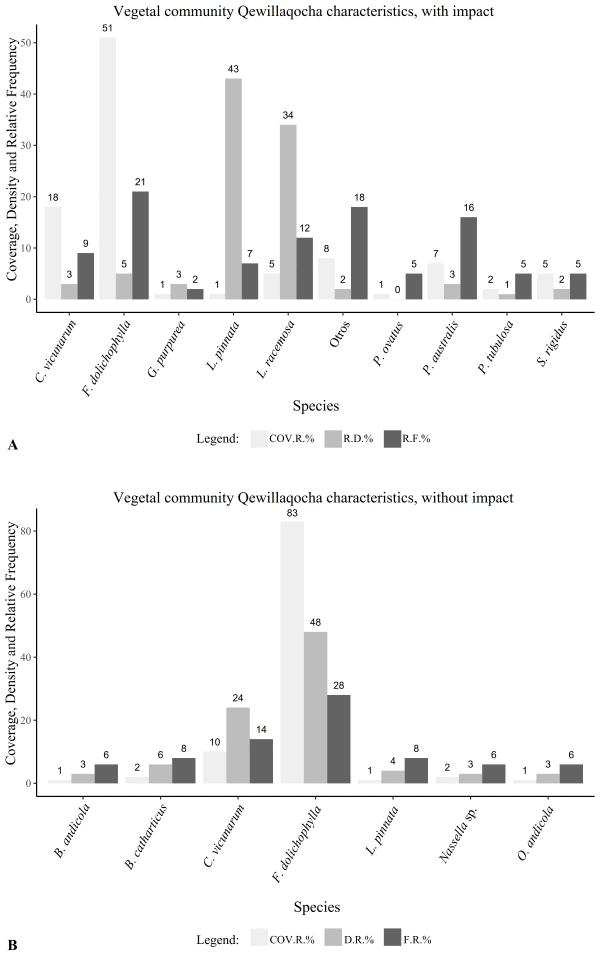
Figure 7 Frequency, density and relative cover of species in the locality of Qewillaqocha, with and without fire impact. Chiara. Ayacucho-2021
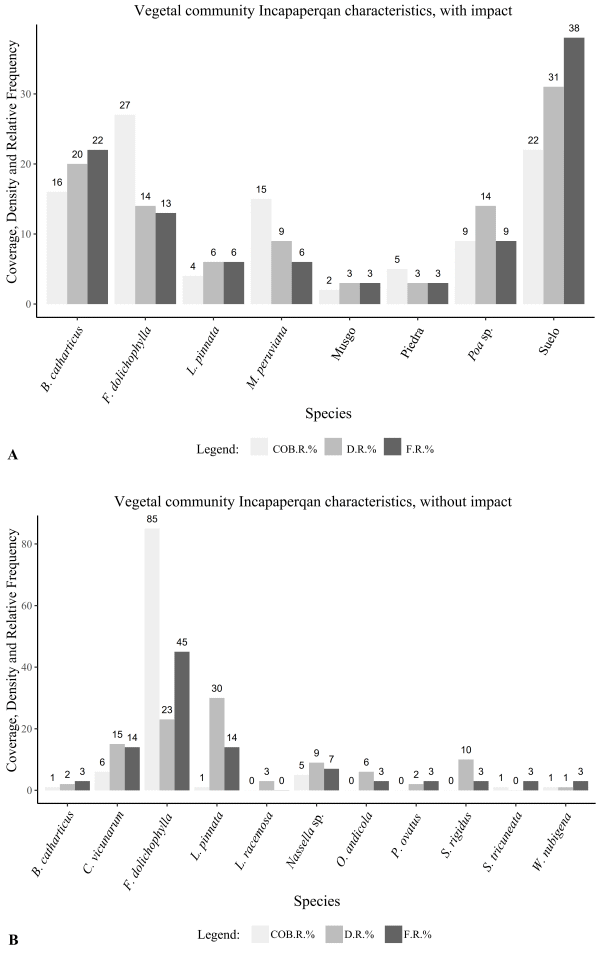
Figure 8 Frequency, density and relative cover of species in the locality of Incapaperqan, with and without fire impact. Chiara. Ayacucho-2021
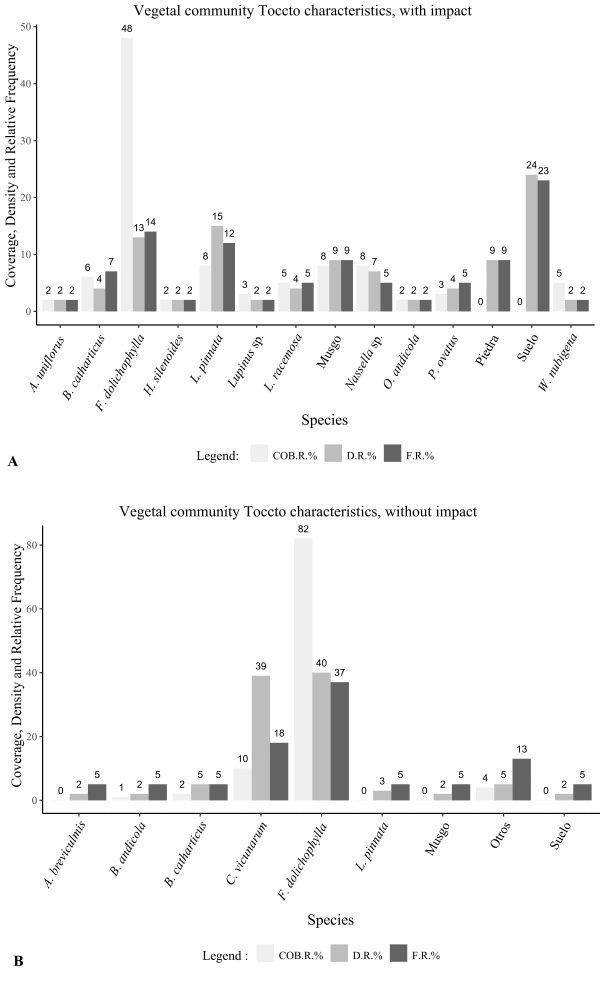
Figure 9 Frequency, density and relative cover of species in the locality of Toccto, with and without fire impact. Chiara. Ayacucho-2021
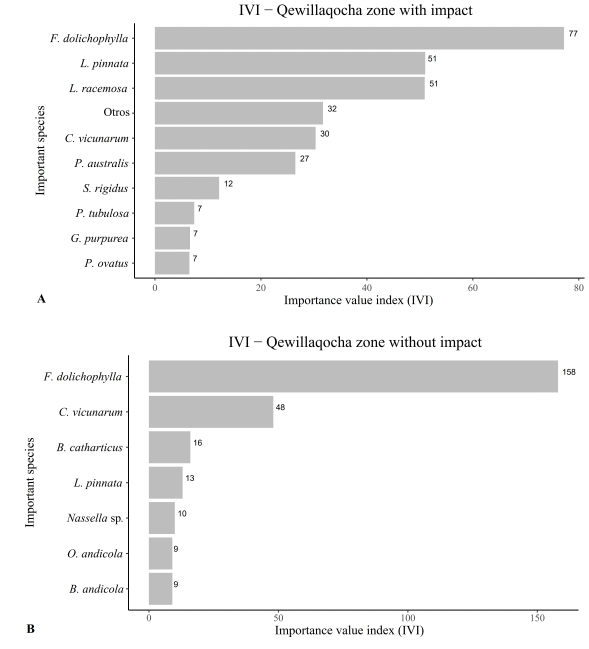
Figure 10 Importance value index of vegetation in the locality of Qewillaqocha, with and without Chiara impact. Ayacucho-2021
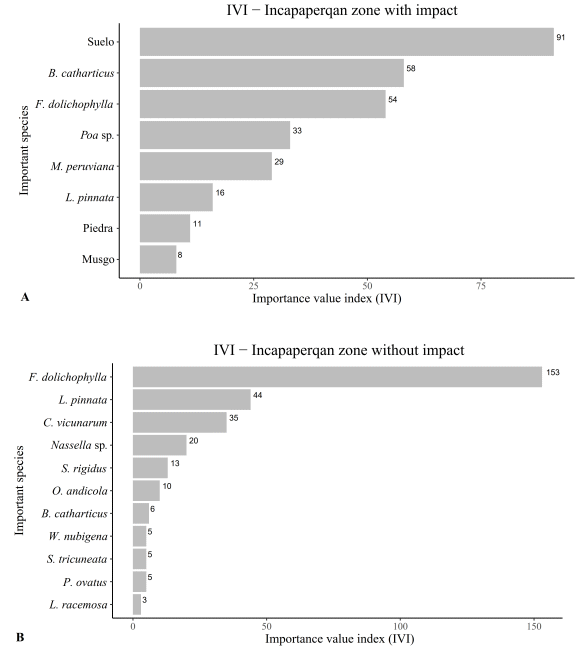
Figure 11 Importance value index of vegetation in the locality of Incapaperqan, with and without Chiara impact. Ayacucho-2021
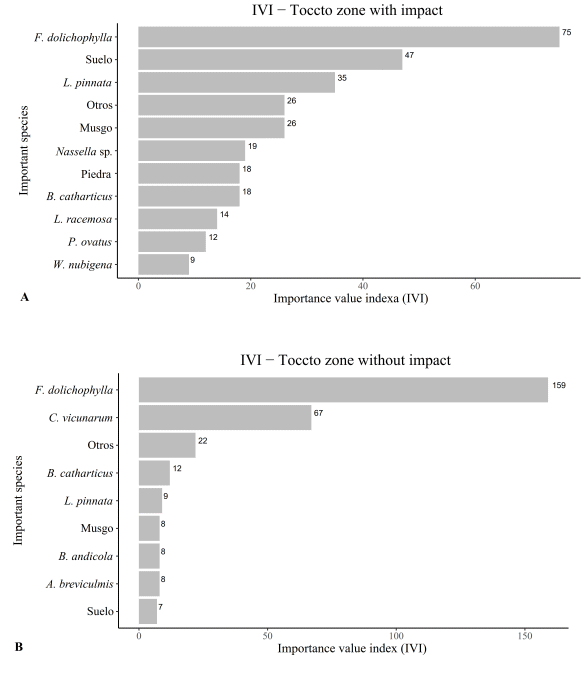
Figure 12 Importance value index of vegetation in the locality of Toccto with and without Chiara impact. Ayacucho-2021
Discussion
A database of the flora of the study area with and without impact has been generated (Table 1), represented by 11 families, 24 genera and 26 species. Being Asteraceae the most frequent in each of the sampling points, 7 genera and 8 species, followed by Poaceae 7 genera and 7 species and the others with a lower number of species. However, in order to further investigate the flora of these fragile ecosystems, an inventory was taken in the areas adjacent to the sampling points, reporting a total of 156 species. Magnoliopsida 116 species and Liliopsida 40 species.
Information that facilitated the evaluation of the characteristics of the communities in the 3 study zones. Qewillaqocha Figure 7a with impact, the most frequent species were F. dolichophylla, P. australis, L. racemosa, C. vicunarum with 21, 16, 12 and 9 % each, the other species with less frequency. Similarly, in terms of cover, F. dolichophyla had the highest cover, followed by C. vicunarum with 51 and 16 %, the rest of the species with lower cover. This explains the habit and growth form of the two species, which are grasses. It is necessary to emphasize that F. dolichophylla is the main component of the high Andean grasslands, it is characterized by forming tillers, a type of aggregate vegetative growth that has allowed it to survive, thus showing its ability to resprout and resist the periodic burns that occur from time to time. They sprout easily with the first rains of the season and are available as fodder for cattle and sheep in the area. This form of growth is a particular characteristic of several high Andean cespitose species that grow at ground level, others have subway stems that allow them to survive. Regarding their density, the greatest number of individuals was observed in creeping, cespitose species such as L. pinnata 43 %, L. racemosa 34 % and the others with a lower number of individuals. This reflects that there is no correlation between density and cover, in this case, they are small species, they grow mostly in an accumulated form, while the others are of greater growth, foliage and biomass.
Tabla 2 Índice de diversidad de las zonas de muestreo: Qewillaqocha, Incapaperqan y Toccto, Chiara. Ayacucho-2021
| Variable | PZ-CI | PZ-SI | SZ-CI | SZ-SI | TZ-CI | TZ-SI |
|---|---|---|---|---|---|---|
| Especies | 17 | 13 | 7 | 11 | 12 | 13 |
| Individuos | 204 | 80 | 34 | 92 | 39 | 96 |
| Dominance_D | .303 | .2916 | .2024 | .1815 | .1571 | .3112 |
| Simpson_1-D | .697 | .7084 | .7976 | .8185 | .8429 | 0.6888 |
| Shannon_H | 1.622 | 1.709 | 1.739 | 1.934 | 2.113 | 1.557 |
| Margalef | 3.009 | 2.738 | 1.701 | 2.212 | 3.003 | 2.629 |
| Equitability_J | .5727 | .6663 | .8936 | .8064 | .8505 | .607 |
Tabla 3 Índice de diversidad según Shannon - Wienner (H) de las zonas de muestreo: Qewillaqocha, Incapaperqan y Toccto. Chiara. Ayacucho-2021
| Zonas | H | Varianza | t | df | Valor p |
|---|---|---|---|---|---|
| PZ-CI | 1.622 | .008 | -.5227 | 149.9600 | .6020 |
| PZ-SI | 1.709 | .019 | |||
| SZ-CI | 1.739 | .013 | -1.3702 | 76.7740 | .1746 |
| SZ-SI | 1.934 | .008 | |||
| TZ-CI | 2.113 | .021 | 2.9263 | 97.4620 | .0043 |
| TZ-SI | 1.557 | .016 |
Tabla 4 Índice de diversidad según el índice de Dominancia (D) de las zonas de muestreo: Qewillaqocha, Incapaperqan y Toccto. Chiara. Ayacucho-2021
| Zonas | D | Varianza | t | df | Valor p |
|---|---|---|---|---|---|
| PZ-CI | .303 | .0005 | .2360 | 125.0300 | .8138 |
| PZ-SI | .292 | .0018 | |||
| SZ-CI | .2024 | .0013 | .5045 | 57.3540 | .6158 |
| SZ-SI | .1814 | .0004 | |||
| TZ-CI | .1571 | .0010 | -3.4178 | 107.6300 | .0009 |
| TZ-SI | .3112 | .0010 |
In Qewillaqocha (Figure 7b) without impact, an ecosystem that has not suffered IF, but located very close to the previous zone. They were evaluated to see whether or not there was a difference in their floristic composition and structural characteristics related to frequency, cover and relative density. It is observed that F. dolichophylla is the most representative in this plant formation, with a frequency of 28 %, coverage 83 % and density 48 %, followed by C. vicunarum 14, 10 and 24 % respectively, the others with minimal representation. This is due to the fact that these species form the grasslands, grow densely and occupy almost the entire area and do not allow other species to grow.
In the second sampling zone, Incapaperqan, which suffered FI in 2021 (Figure 8a) with impact, structural characteristics different from the first sampling zone, affected 1 year earlier, are observed. The existence of bare soil is noticeable; there is still not much vegetation cover. Plant species are just appearing, the regrowth of perennial and ephemeral plants was very slow. However, it was necessary to highlight the presence of very frequent species such as B. catharticus, F. dolichophylla, Poa sp. and M. peruviana. In the same zone (Figure 8b), but without impact, F. dolichophylla was observed, the most representative in terms of frequency, cover and density. As in the first zone, this species was the most dominant according to the parameters evaluated, followed by L. pinnata and C. vicunarum. It is necessary to mention that the physiography of this zone is different from the first one. The third sampling zone, Toccto (Figure 9a), ecosystem impacted by IF in 2021, is very similar to the second sampling zone, the regeneration of the ecosystem is in process, they are still recent shoots, in each established transect it was clearly noted scarce vegetation cover and greater area of bare soil, presence of few species in isolation, others conglomerated according to the growth characteristics of each species. The resprouts of F. dolichophylla are in their splendor with 48 % cover in relation to other species of cespitose growth, such as Asteraceae, legumes, and even grasses. In the same area (Figure 9b), but in vegetation not impacted by IF, as in the previous areas without impact. According to the parameters studied, F. dolichophylla was observed as the most frequent 37 %, followed by C. vicunarum 18 %, the others with lower percentages, as well as density and cover 85 and 82 % respectively.
Regarding the IVI in the first sampling zone Qewillaqocha (Figure 10a) with impact we observed that F. dolichophylla was the most important followed by L. pinnata and L. racemosa. While in the zone without impact (Figure 10b), the same species F. dolichophylla was the most important, which reinforces the results of the structural characteristics of each sampling zone with respect to frequency, cover and relative density, followed by C. vicunarum, B. catharticus and the others with lower percentages. These species were dominant, with very dense growth in undisturbed ecosystems, not allowing the growth of other species.
In the second sampling zone, Incapaperqan locality (Figure 11a) with impact, the IVI highlights bare soils as dominant, due to little vegetation cover, they are in the process of recovery, considering the fire that occurred recently in 2021. Therefore, resprouts are recent, B. catharticus, F. dolichophylla and others are slowly regenerating and forming cover of these ecosystems. If we compare the IVI of the same zone without impact (Figure 11b), we observe that F. dolichophylla was of greater importance, followed by L. pinnata and C. vicunarum.
In the third sampling zone, Toccto locality with impact (Figure 12a), we observed that the IVI is represented by F. dolichophylla, one of the species that recovers gradually, followed by the frequency of bare soils, without vegetation and slow recovery. Also, pioneer species that resprout quickly such as L. pinnata, mosses and Nassella sp., are observed. While in the vegetation without impact (Figure 12b), the IVI indicates F. dolichophylla as the most important, a species that forms the dense high Andean grasslands, few species grow next to them such as C. vicunarum, B. catharticus, L. pinnata among others.
When comparing the different points and the three sampling zones, Qewillaqocha (PZ-CI and PZ-SI), Incapaperqan (SZ-CI and SZ-SI) and Toccto (TZ-CI and TZ-SI) (Figure 13), the Dendrogram shows a similarity of 0.47, forming three groups. Group I is formed by the zones without impact PZ-SI, TZ-SI and SZ-SI, these 4 zones have more species in common when compared with the impact zone. Group II, zones with impact SZ-CI and TZ-CI, show a greater number of species in common. Group III, formed by the PZ-CI impact zone, is less similar to the others. This would indicate that there is a great difference in the floristic composition and structural characteristics of vegetation between the impacted and non-impacted zones.
In relation to species richness (Table 2), it is observed that according to Shannon and Wiener's calculations there is a low diversity and richness, which agrees with Simpson & Margalef. Except in the third study zone, which corresponds to the locality of Toccto, which is moderately diverse. This would indicate that these ecosystems are in the process of regeneration and that currently the post-fire flora is formed by those species that have developed a series of morpho-anatomical adaptations and forms of growth to survive the action of the fires, develop subway stems, or the way to grow accumulated. Similarly, a comparison between study zones in relation to the diversity indexes (Shannon-Wienner and Dominance) shows that there is no significant difference in diversity between the study points with and without impact in Qewillaqocha (PZ-CI and PZ-SI) and Incapaperqan (SZ-CI and SZ-SI), However, in Toccto, the TZ-CI and TZ-SI points show a significant difference in the diversity indexes, with the TZ-CI point being more diverse and the TZ-SI point showing greater dominance (Table 3 and 4).
These results of the high Andean grassland species affected by fires are gradually recovering by resprouting. It has been observed "in situ" that the "ichu" species are not completely burned, there are clumps on the ground, which are reactivated and resprout. There are few specimens that were totally burned, they no longer regenerate, but they are in smaller percentage. In this regard, due to the effect of fires, there is an apparent temporary loss of diversity of vegetation, which then recovers, as has occurred in other similar ecosystems12. Fire generates different responses in vegetation, most ecosystems provide stability in them. If there were no fire, plant communities would support an excessive accumulation of combustible material, stagnation of growth and inadequate reproduction28.
Frequent species with greater coverage present subway bulbs, other forms of propagation and do not burn completely, these are the species that recover quickly, while others that propagate by seeds wait for favorable environmental conditions such as the rainy season. Fire has a negative effect on ecosystems, affecting biodiversity, distribution, abundance of species, affecting habitat and the ecological niche of species4.
After the fire, in each of the ecosystems studied, the landscape looked calamitous, a totally black landscape full of ashes. Today, however, these ecosystems have recovered, and there is an immense greenness in the entire impacted area. It is surprising how the diversity of plant species have managed to survive and recover, not all of them, but most of them. Possibly the fauna is the most affected. It is necessary to highlight the dominance of one species, F. dolichophylla, in the recovery process.
In this regard, it is necessary to emphasize that species, populations, communities and ecosystems are dynamic, subject to change, adapting to environmental changes caused by interactions between organisms. In this sense, understanding them can help us to sustain these living systems, instead of continuing to degrade and destroy them29.
The post-fire regeneration of species is related to their vital characteristics and their ability to resprout. Most of the surviving individuals have a subway part that facilitates regrowth, and the strength of the regrowth determines the success of post-fire regeneration30, the FI not only affects the vegetation, but also the edaphic communities, affecting their composition, density and diversity2. They also affect soil properties, increasing pH values and exchangeable bases, generating a decrease in the concentration of nutrients in soils and loss of OM9.
Therefore, when a fire occurs, the soil undergoes a series of changes in its physical, chemical and biological properties, depending on the intensity and duration of the fire. When repeated fires occur, soil structure degrades, soil erosion increases and soil fertility decreases, leading to significant nutritional impoverishment31.
MO values increase, as well as N, P and K; the opposite happens with the pH of the burned soil, which decreases, that is, it becomes more acidic, depending on the soil depth, intensity, frequency and time of exposure to heat32.
When the FI is of low intensity, it contributes to the cycle of some nutrients, facilitating the control of pathogens in plants and preventing soil erosion. Meanwhile, a high intensity fire eliminates OM, evaporates greater amounts of nitrogen and essential nutrients, changes the soil structure and lowers its productive potential. The forest yielded a greater number of actinomycetes and arbuscular mycorrhizal fungi (AMF) associated with a greater assimilation of nutrients such as potassium32, decrease absorption, water retention, porosity, aeration and infiltration capacity, producing a reduction in the availability of water in the soil and an increase in surface runoff, thus generating erosion33.
Fire affects soil biological activity, which results in unstable nutrient cycling, decreases microorganisms that participate in the processes of MO decomposition and nutrient availability. They indicate that FIs affect the soil resource and will suffer overheating34.
The research made it possible to record 11 families, 24 genera and 26 species at the sampling points. Considering the adjacent areas, 156 species in 27 families and 96 genera of phanerogamic flora, whose composition varies among the three sampling zones. The burned areas have a greater richness of species in relation to areas without impact. Likewise, the species with the highest frequency and coverage both in areas with and without impact are F. dolichophylla, C. vicunarum, L. pinnata, L. racemosa and M. peruviana. In the 3 areas studied: Qewillaqocha, Incapaperqan and Toccto, the diversity indices are very low, even in areas with and without impact. The areas affected by fire recover with the first rains and are in full splendor between 4-5 years. F. dolichophylla does not die completely in the fire, as well as cespitose species, which are easy to resprout. The regeneration of species that propagate by seeds is very slow. Regarding social perception, the people of Chiara are aware of the effects of forest fires.
Therefore, this work will be an important contribution to understand the natural regeneration of vegetation, soil characteristics and the perception of the local population to these events in Andean ecosystems. This contribution will help to improve ecosystem management measures and will facilitate research and impact studies for interested people and institutions. It will allow the development of conservation programs in its broadest sense and make available the information generated. Considering that the Peruvian territory includes unique ecosystems at world level, exclusively or shared with neighboring countries. Unique ecosystems that harbor communities of extreme importance due to the presence of endemic species and species of economic use35.
REFERENCES
1. Castillo M, Pedernera P, Peña E. Incendios forestales y medio ambiente: una síntesis global. Ambient Desarrollar 2003;19(3-4):44-53. [ Links ]
2. Armenteras D, González TM, Vargas Rios O, Meza Elizalde MC, Oliveras I. Fire in the ecosystems of northern South America: advances in the ecology of tropical fires in Colombia, Ecuador and Peru. Caldasia 2020;42(1):1-16. DOI: https://doi.org/10.15446/caldasia.v42n1.77353 [ Links ]
3. Chen Y, Morton DC, Jin Y, Gollatz GJ, Kasibhatla PS, van der Werf GR, et al. Long-term trends and interannual variability of forest, savanna and agricultural fires in South America. Carbon Manag 2013;4(6):617-38. DOI: https://doi.org/10.4155/cmt.13.61 [ Links ]
4. Müller D, Suess S, Hoffmann AA, Buchholz G. The value of satellite-based active fire data for monitoring, reporting and verification of REDD+ in the Lao PDR. Hum Ecol 2013;41(1):7-20. DOI: https://doi.org/10.1007/s10745-013-9565-0 [ Links ]
5. De Castro R, Simarro ME, Priego C, Lafuente R, Sancho A. Investigación social sobre los incendios forestales en Andalucía [Internet]. Sevilla: Wild-fire; 2007 [citado 22 de octubre de 2019]. Recuperado a partir de: https://www.juntadeandalucia.es/medioambiente/portal/documents/20151/589228/investigacion_social_sobre_los_incendios_forestales.pdf/6c311d39-9998-7634-8426-2c64abfecf2d?t=1434960586000 [ Links ]
6. Capulín Grand J, Mohedano Caballero L, Razo Zarate R. Changes in soil and vegetation in a pinus forest affected by fire. Terra Latinoam 2010;28(1):79-87. [ Links ]
7. Chamizo A, Hernández J. Metodología para la estimación de vulnerabilidad en Ecuador, Perú y Bolivia [Internet]. Guayaquil: Centro Internacional para la Investigación del Fenómeno de El Niño; 2014 [citado 22 de septiembre de 2019]. 48 p. Recuperado a partir de: http://geonode.ciifen.org/documents/1134#more [ Links ]
8. Verzino G, Joseau J, Dorado M, Gellert E, Rodríguez Reartes S, Nóbile R. Impact of fires on plant diversity, sierras of Córdoba, Argentina. Ecol Apl 2005;4(1-2):25-34. DOI: https://doi.org/10.21704/rea.v4i1-2.294 [ Links ]
9. BeltránPineda ME, Lizarazo-Forero LM. Grupos funcionales de microorganismos en suelos de páramo perturbados por incendios forestales. Rev Ciencias 2013;17(2):121-36. DOI: https://doi.org/10.25100/rc.v17i2.490 [ Links ]
10. Fernández-Méndez F, Velasco-Salcedo VM, Guerrero-Contecha J, Galvis M, VianaNeri A. Ecological recovery of affected areas by a forest fire in the Tintales watershed (Boyacá, Colombia). Colomb Forestal 2016;19(2):146-60. DOI: https://doi.org/10.14483/udistrital.jour.colomb.for.2016.2.a02 [ Links ]
11. Rosales-Rodríguez JA, Esquivel-Segura EA, Acevedo-Tapia MA, González-Ortega M, Cartes-Rodríguez E. Pre and post-fire situation, of an eco-system of the Roble-Hualo forest type, Maule region, Chile. Kurú 2019;16(38):55-68. DOI: https://doi.org/10.18845/rfmk.v16i38.3997 [ Links ]
12. Aponte H, Ramírez W, Lértora G, Vargas R, Gil F, Carazas N, et al. Fire on wetlands of the central coast of Peru: ¿a common threat?. Cientifica 2015; 12(1):70-81. DOI: https://doi.org/10.21142/cient.v12i1.166 [ Links ]
13. PachecoIsasi AE. Efecto del fuego sobre las comunidades vegetales de pastizales y matorrales en el Anexo de Totorani, Distrito de Polobaya, Arequipa, Octubre- Diciembre, 2018 [tesis licenciatura]. [Arequipa]: Universidad Nacional de San Agustín de Arequipa; 2019 [citado 26 de octubre de 2019]. Recuperado a partir de: http://www.secheresse.info/spip.php?article103047 [ Links ]
14. Hermitaño Montalvo HR, Crisóstomo Hilario XB. Efecto de la quema de pastizales en las propiedades de los suelos en Huamancaca Chico. Huancayo. 2020 [tesis licenciatura]. [Huancayo]: Universidad Continental; 2021 [citado 16 de septiembre de 2019]. Recuperado a partir de: https://repositorio.continental.edu.pe/handle/20.500.12394/10349 [ Links ]
15. Gerencia Regional de Recursos Naturales y Gestión del Medio Ambiente. Desarrollo de capacidades en zonificación ecológica económica y ordenamiento territorial en la región Ayacucho [Internet]. Ayacucho: Gerencia Regional de Recursos Naturales y Gestión del Medio Ambiente; 2012 [citado 2 de octubre de 2019]. 75 p. Recuperado a partir de: https://es.scribd.com/document/401702626/CLIMATOLOGIA-DE-LA-REGION-AYACUCHO-pdf [ Links ]
16. Martínez Cabrera R. Estrategia regional de cambio climático Ayacucho: componente de diagnóstico y planeamiento [Internet]. Ayacucho: 2015. Gobierno Regional de Ayacucho [citado 12 de septiembre de 2019]. 288 p. Recuperado a partir de: https://docplayer.es/89971916-Estrategia-regional-de-cambio-climatico-ayacucho-componente-de-diagnostico-y-planeamiento.html [ Links ]
17. Terán-Valdez A, Duarte N, Cuesta F, Pinto E. Practicando la restauración ecológica: el monitoreo y mantenimiento de áreas. En: Proaño R, Duarte N, Cuesta F, Maldonado G, editores. Guía para la restauración de bosques montanos tropicales [Internet]. Quito: CONDESAN; 2018. p. 5-79. Recuperado a partir de: https://restoration.elti.yale.edu/resource/modulo-4-practicando-la-restauracion-ecologica-el-monitoreo-y-mantenimiento-de-areas [ Links ]
18. Loyola Gonzales R, Portuguez Yactayo H, Matos Delgado D, Araujo Flores S, Millán Salazar B, Arana Bustamante C, et al. Guía de inventario de la flora y vegetación [Internet]. Lima: Ministerio del Ambiente. Dirección General de Evaluación, Valoración y Financiamiento del Patrimonio Natural; 2015 [citado 22 de octubre de 2019]. 49 p. Recuperado a partir de: https://www.gob.pe/institucion/minam/informes-publicaciones/2683-guia-de-inventario-de-la-flora-y-vegetacion [ Links ]
19. Mostacedo B, Fredericksen T. Manual de Métodos Básicos de Muestreo y Análisis en Ecología Vegetal [Internet]. Santa Cruz de la Sierra, Bolivia; 2000. 92 p. Recuperado a partir de: http://www.bionica.info/biblioteca/mostacedo2000ecologiavegetal.pdf [ Links ]
20. Lot A, Chiang F. Manual de herbario: Administración y manejo de colecciones, técnicas de recolección y preparación de ejemplares botánicos [Internet]. Vol. 36, Taxon. México: Consejo Nacional de la flora de México; 1986. 300 p. Recuperado a partir de: https://itvolivre.wordpress.com/2013/09/28/manual-de-herbario-lot-antonio-chiang-fernando-1986/ [ Links ]
21. TovarSerpa Ó. Las Gramíneas (Poaceae) del Perú [Internet]. Madrid: Real Jardín Botánico; 1993 [citado 22 de julio de 2019]. 480 p. Recuperado a partir de: https://bibdigital.rjb.csic.es/records/item/1525858-las-gramineas-poaceae-del-peru?offset=1 [ Links ]
22. Herbario Rapid Reference [Internet]. Chicago: The Field Museum, 2020 [cited 10 October 2021]. Retrieved from: https://plantidtools.fieldmuseum.org/es/rrc/5581 [ Links ]
23. Tropicos.org: Missouri Botanical Garden [Internet]. Missouri: Base de Datos de Tropicos; 2022 [cited August 15, 2022]. Retrieved from: https://www.tropicos.org/home [ Links ]
24. Comisión Nacional para el Conocimiento y Uso de la Biodiversidad. Sistema de Clasificación de Cronquist [Internet]. Mexico: Columbia University Press; 1981 [citado 22 de octubre de 2019]. 53 p. Recuperado a partir de: https://reinaldolozano.files.wordpress.com/2012/10/cronquist1980.pdf [ Links ]
25. Theplantlist.org: the plant list. a working list of all plant species [Internet]. Misoure: the plant list; 2013 [citado 15 de octubre de 2020]. Recuperado a partir de: http://www.theplantlist.org [ Links ]
26. Matteucci S, Colma A. Metodología para el estudio de la vegetación [Internet]. Washington: Secretaria General de la Organización de los Estados Americanos, Programa Regional de Desarrollo Científico y Tecnológico; 1982 [citado 22 de octubre de 2019]. 165 p. Recuperado a partir de: https://www.researchgate.net/publication/44553298_Metodologia_para_el_estudio_de_la_vegetacion_por_Silvia_D_Matteucci_y_Aida_Colma [ Links ]
27. Medrano Meraz M de J, Javier Hernández F, Corral Rivas S, Nájera Luna JA. Diversidad arbórea a diferentes niveles de altitud en la región de El Salto, Durango. Rev Mex Ciencias For. 2017;(40) :57-68. DOI: https://doi.org/10.29298/rmcf.v8i40.36 [ Links ]
28. Farfán Loaiza RD, Farfán Tenicela ER. Producción De Pasturas Cultivadas Y Manejo De Pastos Naturales Altoandinos [Internet]. Naturales Altoandinos, editor. Moquegua, Perú: INIA-Gobierno Regional de Moquegua; 2012. 249 p. Recuperado a partir de: http://pgc-snia.inia.gob.pe:8080/jspui/handle/inia/417 [ Links ]
29. VillalobosRueda L. Ecología y Medio Ambiente [Internet]. Managua: Universidad Nacional Agraria; 2006 [citado 22 de octubre de 2019]. 72 p. Recuperado a partir de: https://repositorio.una.edu.ni/2441/ [ Links ]
30. López-Soria L, Castell C. Comparative genet survival after fire in woody Mediterranean species. Oecologia 1992;91(4):493-9. DOI: https://doi.org/10.1007/BF00650321 [ Links ]
31. Iglesias López MT, González Palma J (dir), Fernández Bermejo C (dir). Efectos de los incendios forestales sobre las propiedades del suelo en un pinar de repoblación (Pinos pinaster), en Arenas de San Pedro [tesis doctoral]. [Madrid]: Universidad Complutense de Madrid; 1993 [citado 26 de octubre de 2019]. Recuperado a partir de: https://docta.ucm.es/entities/publication/3daa45b1-2f4b-45f8-88b5-82ba7759f9da [ Links ]
32. Calderón-Medina CL, Bautista-Mantilla GP, Rojas-González S. Chemical, physical and biological soil properties, indicators of the status of different ecosystem in a high terrace of the Meta department. Orinoquia 2018;22(2):141-57. DOI: https://doi.org/10.22579/20112629.524 [ Links ]
33. Mataix-Solera J, Guerrero C. Efectos de los incendios forestales en las propiedades del suelo [Internet]. Alicante: CEMACAM Font Roja; 2007 [citado 22-de octubre de 2019]. 40 p. Recuperado a partir de: https://www.researchgate.net/profile/Jorge-Mataix-Solera/publication/229187257_Efectos_de_los_incendios_forestales_en_las_propiedades_edaficas/links/0fcfd500835635e07c000000/Efectos-de-los-incendios-forestales-en-las-propiedades-edaficas.pdf [ Links ]
34. Rosero Cuesta J, Osorio Giraldo I. Efectos de los incendios forestales en las propiedades del suelo. Estado del arte. Cuaderno Activa 2014;5(1):59-67. [ Links ]
35. BrackEgg A, ArandaArce C, BernalesAlvarado ME, BustamanteMorote R, CamposBaca L, CapurroVillarán F, et al. Diagnóstico ambiental del Perú [Internet]. Lima: Ministerio del Ambiente; 2008 [citado 22 de octubre de 2019]. 69 p. Recuperado a partir de: https://sinia.minam.gob.pe/download/file/fid/39199 [ Links ]
Source of financing The research project was self-financed, with minimal logistical support from the Universidad Nacional de San Cristobal de Huamanga through the former FEDU.
Conflicts of interest The work was carried out in the transect of the Ayacucho - Cusco highway, located in the district of Chiara, province of Huamanga. Ayacucho-Peru. The authors declare that they have no conflicts of interest.
Acknowledgments We thank the inhabitants of the community of Chiara for their support in carrying out this research, Marleny Prada, Bill and Ronal for their support in field work.
Ethical considerations The authors comply with the ethical standards for publication. With the knowledge of the General Research Office of the Universidad Nacional de San Cristóbal de Huamanga.
Authors' contributionDe La Cruz-Arango Jesús, planning of the experiment, systematization and interpretation of the information, revision of the final document. Cóndor Alarcón Reynán, statistical analysis, systematization and interpretation of the information, revision of the document.
Editor's Note: Journal of the Selva Andina Biosphere (JSAB). All statements expressed in this article are solely those of the authors and do not necessarily represent those of their affiliated organizations, or those of the publisher, editors and reviewers. Any product that may be evaluated in this article, or claim that may be made by its manufacturer, is not guaranteed or endorsed by the publisher.
Received: November 01, 2022; Revised: January 01, 2022; Accepted: March 01, 2023











 texto en
texto en 
 uBio
uBio 

